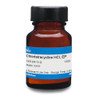Chlorotetracycline HCl, EP is tetracycline antibiotic and the first antibiotic of the tetracycline class to be discovered. Chlorotetracycline HCl is soluble at 8.6 mg/mL.
Chlortetracycline HCl, EP meets European Pharmacopoeia (EP) specifications.
| Mechanism of Action | The mechanism of chlorotetracycline involves entering a cell and binding to the 30s ribosomal subunit preventing peptide elongation and ultimately inhibiting protein synthesis. Resistance to chlorotetracycline can be a result of inactivation by cell enzymes or pumping the antibiotic out of the cell upon entering. |
| Spectrum | Chlorotetracycline is a broad spectrum antibiotic targeting a wide variety of gram positive and gram negative bacterial cells. |
| Microbiology Applications | Chlorotetracycline HCl is commonly used in clinical in vitro microbiological antimicrobial susceptibility tests (panels, discs, and MIC strips) against gram positive and gram negative microbial isolates. Medical microbiologists use AST results to recommend antibiotic treatment options for infected patients. Representative MIC values include:
|
| Plant Biology Applications | Chlortetracycline, in combination with colistin and gentamicin have been successfully used in sweet cherry (Prunus avium L). tissue culture to eliminate Pseudomonas spp. contaminants. |
| Molecular Formula | C22H23ClN2O8· HCl |
| Impurities | 4-EPI CTC≤4.0% CTC-HCl≥89.5% (dried basis) TC-HCl≤8.0% (dried basis) TC-HCl+CTC-HCl: 94.5-100.5% (dried basis) |
| References | Hierowski, Marian. "Inhibition of Chlortetracycline Protein Synthesis in the E. coli In Vitro System.." PNAS 53.3 (1965): 594-99. www.ncbi.gov. Web. 10 Sept. 2012. Leifert C., Ritchie J.Y. and Waites W.M., Contaminants of plant-tissue and cell cultures. World Journal of Microbiology and Biotechnology 7. 452469. |
| MIC | Bordetella bronchiseptica| ≤0.5 - 1|| Diplococcus pneumoniae| 0.02 - 0.4|| Escherichia coli| ≥32|| Fusobacterium necrophorum| 0.1 - 6.3|| Haemophilus influenzae| 0.8 - 3.1|| Haemophilus parasuis| ≤0.5 - 8|| Lawsonia intracellularis | 0.125 - 64|| Mycoplasma gallisepticum| 0.05 - 1.56|| Mycoplasma hyosynoviae| 0.5 - >4|| Mycoplasma synoviae | 0.05 - 12.5|| Nocardia asteroides| 12.5 - 50|| Pasteurella multocida| 1 - 4|| Salmonella enterica| 8 - >32|| Streptococcus suis| ≤0.5 - >32|| Treponema hyodysenteriae | 6.25 - >100|| |








